Waymarkers – Finding your way on The Camino
One of the (many) joys of The Camino is that you don´t need to be pending on any apps or maps to guide your way. Just look around you, enjoy the scenery and keep your eyes peeled for the next waymarker.
The Camino is for everyone. Thankfully you don´t need to have completed an orienteering course or be a skilled map reader to walk or cycle it. One of the (many) joys of The Camino is that you don´t need to be pending on any apps or maps to guide your way. Just look around you, enjoy the scenery and keep your eyes peeled for the next waymarker.
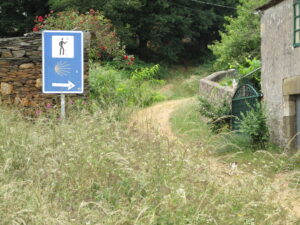
I´m always fascinated by the sheer variety of waymarkers on The Camino. The imaginative use of stones, wooden posts, walls, buildings, the ground, the trees, etc etc to paint yellow arrows on to mark The Camino is a joy to the eye. The yellow arrows showing you The Way are all around you. So helpful are the waymarkers that when you come to a fork in the path, there is often a yellow cross on one part of the fork clearly marking not this way…that way.
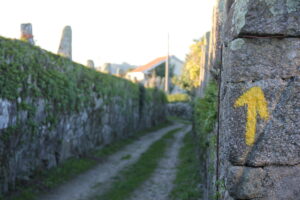


If you were wondering where the origin of theses yellow arrows on the Camino comes from, then you can thank Elias Valiña (1929- 1989) the parish priest of O Cebreiro for that. O Cebreiro is a tiny village on the French Camino in Galicia about 147km from Santiago de Compostela.
In the 1980s, Elias worked tirelessly recuperating old forgotten stretches of the route. Starting in Roncesvalles he painted yellow arrows along the Camino Frances all the way to Santiago de Compostela, with the intention of pointing pilgrims in the right direction and helping them stay on the right track. Why yellow? I hear you ask. Well, simply because it was a highly visible colour, it was free and at hand as it was used by the Department for Transport on road markings. This went on to become the current symbol as we know it today, which we can see not just on The Camino but on merchandising too. Little did he know that he was inadvertently creating a iconic brand recognised the world over.
Such was his dedication to reviving The Camino, that Elias also wrote the first Pilgrim´s Guide and completed a PhD on the subject.
In addition to the yellow arrow, another symbol of the Camino is the scallop shell. Today you will see pilgrims walking to Santiago with the scallop shell hanging from their rucksack. It is worth noting however, that the scallop shell was traditionally, something that was carried back from Santiago de Compostela. They were picked up on the Galician coast and served as additional proof that the pilgrim had reached their destination. As a nod to tradition, on your Camino, why not order a delicious plate of zamburiñas (scallops) and take the shell home with you?



Today, the scallop shell is the symbol of the Camino and it is used on stone markers to show the way. Take the scallop shell as a reassurance that you are on the right path. The scallops are most of the time placed next to a yellow arrow thus indicating the right way at the various tricky crossroads along the trail. But not always, you will also spot them in brass set in the pavement as you walk through more urban areas.
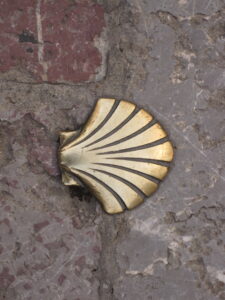


You will also see stone markers which indicate how far you have left to reach Santiago de Compostela. Highly motivational when you see the kilometres steadily go down and down as you get nearer to your destination.
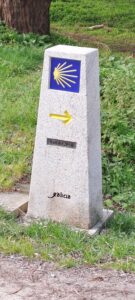


You will also spot on your journey some Pilgrim´s Benches (Banco del Peregrino). The QR code on the bench takes you to information on where you are, how far you have left to go, nearest restaurants and bars and other points of interest. Very welcome, in addition to serving as somewhere to sit on and have a little rest of course!
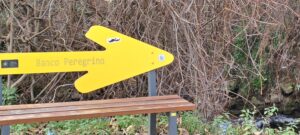


You may find points on your journey where you hesitate and aren´t quite sure which path to take. Or, after a while you realise it´s a long time since you last saw a waymarker and start to wonder if you´ve gone off piste. Be reassured that lurking somewhere nearby is a yellow arrow, stone sign or wooden post pointing you in the right direction. Look around you and you will find arrows on the ground, on the wall, on gates, rocks… If you have been walking or cycling for a while and are starting to feel like you´ve not seen a sign for quite a while and fear you may have charged ahead and missed a turning then pause. Retrace your steps to that turning you weren´t quite sure about and you´ll put yourself on the right track again.
If you are a group of 6 or more and would like us at The Way Experiences to put together a self-guided walking or cycling Camino for you, then you can expect to be provided with a detailed itinerary and our own tried and tested maps. These will more than suffice for those moments of uncertainty. If on the other hand you´ve opted for one of our guided walking or cycling trips then all you need to do is simply relax enjoy the journey and do a bit of waymarker spotting just for the fun of it! So, what´s holding you back?
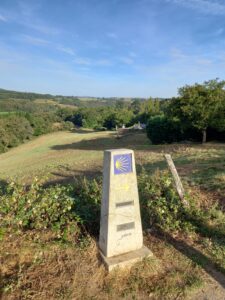


One of the (many) joys of The Camino is that you don´t need to be pending on any apps or maps to guide your way. Just look around you, enjoy the scenery and keep your eyes peeled for the next waymarker.
The French Camino – Maybe not the Original Camino but it is arguably the most Iconic Camino.
The Camino del Norte is an absolutely stunning route steeped in beauty, culture and history. The Northern Way starts in Irún and there are 35 sections and 820 kilometres before you arrive in Santiago de Compostela. This route crosses the whole of the north of Spain. It´s an absolute gem, following the Cantabrian coastline from France to Galicia.
Often overshadowed by the more popular and transited French and Portuguese Way, The Camino del Norte is an absolute gem of a route. The Camino de Santiago originated in ancient times as a pilgrimage taking Christians to visit the tomb of Saint James (Santiago). All routes take you to the Galician city of Santiago de Compostela, and more specifically Santiago Cathedral.
The Jubilee or Jacobean year (Xacobeo) is the year when the day of St James the Apostle (25th of July) falls on a Sunday. This happens about 14 times each century. Every 6, 5, 6 and 11 years apparently. This was decreed by Pope Calixtus II in 1126 and coincided with the laying of the last stone at Santiago de Compostela Cathedral.
The Credencial del Peregrino or Pilgrim´s Passport is a small booklet that you carry with you and get stamped along The Way. Its origins date back to the Middle Ages when the booklet was used quite literally as a passport to provide safe passage to pilgrims travelling to Santiago de Compostela.